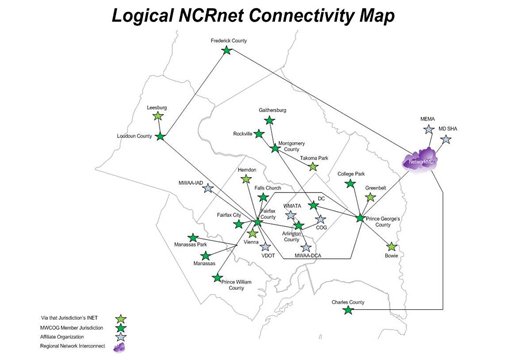The ability to reach emergency first responders is vital to saving lives but in most areas of the country services like 9-1-1 calls still use outdated technologies.Upgraded emergency-communications infrastructure will be vital not only to keeping our region functioning on a daily basis but to avoiding the problems caused when 9-1-1 communications have failed in the past.
While National Capital Region localities have made significant improvements to 9-1-1 systems over the past decade our existing 9-1-1 technologies have essentially preserved a 40 year old technology. Currently 9-1-1 capabilities have limited ability to find users’ location inside of buildings and have a recent history of outages nationwide including the 2012 derecho storm which disabled Xthousands of Virginians ability to receive emergency support (link to COG item on this).
In response to these threats to regional security the COG Board approved a resolution supporting further planning efforts for the next generation of 9-1-1 technology at its September board meeting. This is part of the COG Board’s 2014 Legislative Agenda on critical regional infrastructure. The unanimous vote of the Board to support these efforts came after a briefing led by David Simpson Chief of the Federal Communications Commission’s Public Safety and Homeland Security Bureau Wanda Gibson Fairfax County Chief Information Officer Steve Souder Chair of the Council of Government’s 9-1-1 Directors Committee urging for further efforts to upgrade 9-1-1 infrastructure and Christy Williams 9-1-1 Program Manager for the North Central Texas Council of Governments in the Dallas-Ft Worth region.

Over $100 million has been invested over the past decade across the region simply to improve the current emergency response system. However more is needed and the next generation of 9-1-1 functionality is essential to bridge 9-1-1 into the coming decades. The future of emergency communications nationwide will be furthered by the Washington Region’s advancements which would be not only the largest but the most complex region in the U.S. to take the next crucial step toward contemporary emergency management. This effort will start with implementing text-to-9-1-1. Being able to send a text message to a 9-1-1 dispatch center is a crucial first step as “consumers expect to access 911 through the most popular means of communication” said Simpson.
Currently at least 48 smaller regions use text to 9-1-1 technologies and they have shown promising results in delivering effective safety and emergency response. These next generation technologies will not only include texting capabilities but can also allow 9-1-1 centers to process user-submitted video and pictures to better inform emergency response. Next generation or “next gen” 9-1-1 “could be used to jumpstart other areas and serve as a template” for other large regions said Simpson.
Next gen 9-1-1 promises to improve our emergency communication systems to the point that as Steve Souder explained “the only thing about 9-1-1 that will move forward into the future of next generation 9-1-1 is the number itself.”
Along with these technological enhancements further cooperation between jurisdictions will be needed as emergencies do not know borders. Fairfax County has begun the process to acquire elements of next gen 9-1-1 technology. Using region wide financial tools provided by COG costs of procuring these new life-saving upgrades will be cheaper and easier for other jurisdictions in our region.
About the 2014 Regional Infrastructure Series:
COG has planned a series on regional infrastructure focused on its main areas of expertise such as transportation water energy and public safety communications. Officials hope the series will identify policy advocacy and outreach actions around key infrastructure needs. COG’s officials believe that long-term commitment to capital investment and maintenance of our infrastructure is vital to achieving our Region Forward vision for a more prosperous accessible livable and sustainable metropolitan Washington.
Previous Infrastructure Series Blogs:
• Water Infrastructure Investments Key to Region’s Water Quality Goals Health and Prosperity
• Officials Highlight Metropolitan Washington’s Highway and Bridge Maintenance Needs
• Officials Launch Series with Discussion on Water Infrastructure (Drinking Water)
• Energy Talk Focuses on Future of Newer Infrastructure Greater Reliability and Efficiency